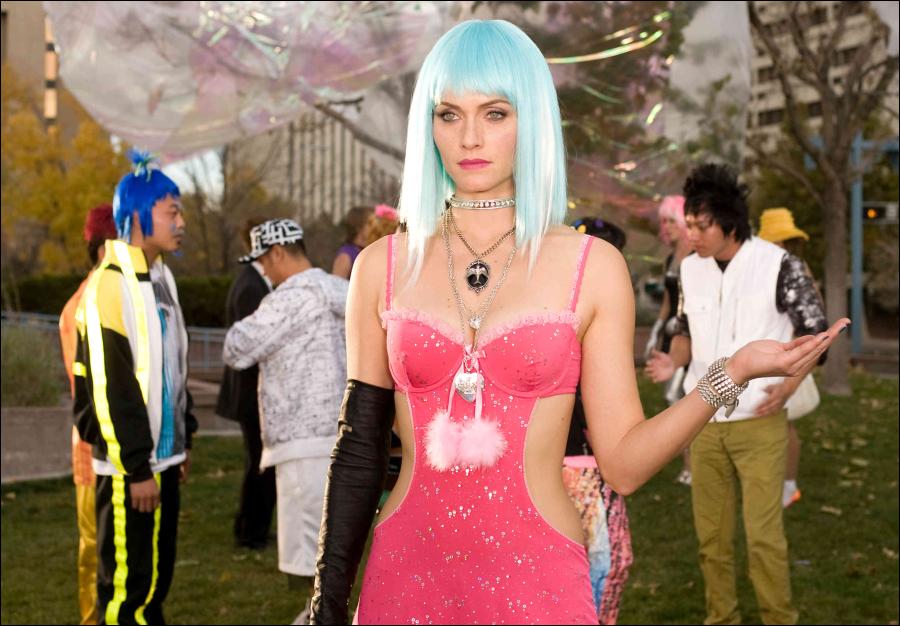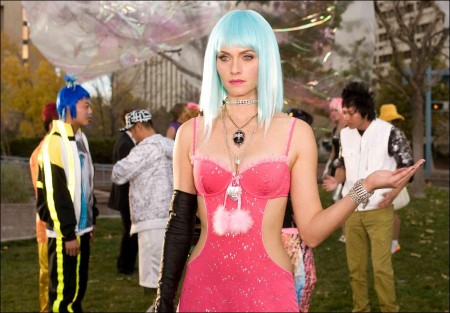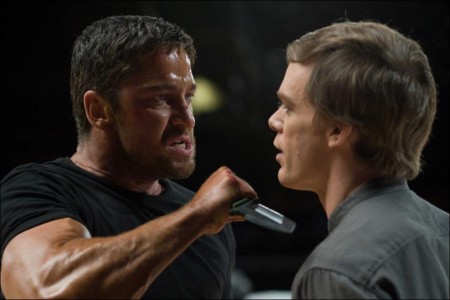About the Production
What if you weren’t in control of your own actions? What could you be forced to do against your will? Have sex with a complete stranger? Kill the people you love? In GAMER, a techno-themed action-thriller set in the not-too-distant future, co-creators Mark Neveldine and Brian Taylor (CRANK) have taken simulated reality into a terrifying new dimension.
Following the success of the CRANK films, which Neveldine and Taylor describe as “pure ADD candy,” the duo wanted to tackle a deeper story featuring bigger ideas and more complex characters. The filmmakers create three unique worlds within GAMER, each with its own filmic style and design.
“The simulated reality game, ‘Slayers,’ is a massive, multiplayer battlefield; ‘Society’ is a tripped-out, fetishistic social-networking community; and then the real world exists outside the games,” explains Neveldine. “Each one has its own look and feeling, its own set of visual rules – from color to camera movement to effects to set design.”
“GAMER has all the hallmarks of Neveldine’s and Taylor’s sick, yet genius minds,” says actor Gerard Butler, who stars as Kable, a gladiator who fights to regain his identity within the gaming system that holds him captive.
“They really have an innate, natural ability to create these kinds of concepts without over-thinking them, while creating great characters and keeping this element of freshness, youth and progressive thinking. They’re very talented.”
Like most successful science fiction, GAMER’s speculations about the future have a firm basis in present day reality. According to producer Tom Rosenberg, that’s part of its appeal. He says, “Although the story is far out, it’s grounded in reality. In fact, everything in the game, although set in the future, is really taking place right now, just to a lesser degree.” Producer Gary Lucchesi agrees.
“I think all the best science fiction is an extension of what you’re currently seeing. You speculate on what’s happening now and exaggerate it. I remember listening to the radio one day coming to work,” he recalls.
“There was a young woman playing an online game who changed her avatar, her online alterimage, into this 6’6” tough guy who carried a gun or a knife, and terrified people. Her alter ego was able to express itself through that video world. I think those fantasies certainly live within all of us.”
After watching his physical, emotionally rich performance in Zach Snyder’s 300, Neveldine and Taylor knew Gerard Butler was the only actor to play Kable. “There are so few true action stars left on this planet, and Gerard is the best,” says Taylor.
“He has incredible physical presence and is willing to do the homework to make the action look real and visceral, as we saw with 300. But at the same time, there is a soul and humanity to his performances that draws you in and involves you emotionally.”
Apart from the originality of the story, Butler was also attracted to the cutting-edge approach of the filmmakers’ style. “I like to take risks,” he says, “and I want to think that any project I do is going to affect people either because it’s a new way of filmmaking, or because of the emotion behind it, or how unusual the story is. GAMER satisfied all of those requirements.”
For the part of Angie Tillman, Kable’s wife who is ensnared in the fetishistic ‘Society’ game, model and actress Amber Valletta faced considerable physical and emotional challenges.
“When I first read the script, I thought, ‘Wow, I’ve never seen anything like this,’” Valletta says. “The genre yes, but not this kind of material. Nothing has ever been made that sounded, looked or felt like it. I’d never seen a woman in a role like this. It felt very modern.”
“Angie is a tough role,” Neveldine admits. “There’s the pain Amber has to go through being controlled, the sexual things the script put her through and the emotions and grief and all that stuff. But she tackled it so well. She surprised us everyday. She was amazing.” Taylor adds, “I don’t think we really knew how good Amber was until she started working. It was pretty awesome, and she’s just a sweetheart.”
Playing living avatars controlled by other people, Butler and Valletta grappled with the challenge of not being allowed to react intuitively to a given situation, a dynamic that is in direct conflict with naturalistic acting. Valletta had to practice being utterly powerless in some of the film’s most difficult scenes, while Butler had to modify every aspect of his physical work.
“Basically, the directors wanted the warriors in the ‘Slayers’ game to move differently, like a character would in a video game,” explains stunt coordinator Darin Prescott.
“So guys will march ahead, kind of turn their guns, and then they’ll turn with it. It’s not as fluid as if guys were just running through battle. There’s also a little delay, or “ping,” as it’s called in the story, which happens when the controlling character makes a move and then the controlled character will make the same move a fraction of a second later.”
The unlikely controller of global action star Kable is Simon, a rich, sequestered teenage boy played by Logan Lerman. For most of the story, Simon is able to control the brutality of the game from the comforts of his high-tech gaming room, which Lerman describes as “working with little orange dots everywhere, which is a little complicated, but you get used to it. You get the flow of things and you adapt to the different style. It’s cool.”
In one particular scene, Simon actually appears on the battlefield with Kable, which was an intimidating experience for Lerman. “It was just so overwhelming,” Lerman says, laughing. “I give a lot of credit to Gerard to be able to focus with explosions going off and people getting shot right in front of him. It’s crazy stuff. I felt more at home in the studio.”
The real mastermind of GAMER’s virtual worlds, however, is Ken Castle, played by Michael C. Hall, the star of Showtime’s hit series, “Dexter.” “Michael was the ideal actor to play Castle,” Taylor avows. “This is one of those performances that people are going to talk about.”
A man who has grown up in the world of video games and the internet, Castle is the creator of the gaming technology in the film’s story. Sequestered in his house, Castle has no need for the outside world, having created a virtual environment of which he is the sole master. Taylor describes Castle as merely one part of a greater dystopian future landscape.
“Castle’s basically trying to control everything,” he explains. “He’s trying to get his hands on everything and make everybody march in step and do exactly what he wants them to do. We’re moving toward a world, I think, where all of us can be Castle.”
For Hall, Castle’s egomania was the most appealing aspect of the part. “Castle believes he’s enlightened in a way that no one else is, that he’s super-human. He doesn’t see himself as evil. He’s like a kid playing in a sandbox.”
The role also gave Hall the opportunity to break away from the somewhat repressed characters he’s played on television. “The part was like getting on a funhouse ride. I got to be unashamed, lascivious, do a Sammy Davis Jr. soft shoe, beat up the action hero of the year while controlling him with my mind, and have a really strange and severe hairstyle all in the same movie.”
Despite GAMER’s dark, cautionary story, Neveldine’s and Taylor’s vision of the future is not completely without hope. A rebel group called the “Humanz” recognizes that Kable has become more popular among the fans of the game than the game itself, and if they can get his support, they stand a chance of tearing down the rapidly growing threat to humanity.
At the head of this organization is a man called “Humanz Brother,” played by Chris “Ludacris” Bridges. “I took on the role because I play the voice of reason in the story,” explains Bridges, who is an avid gamer himself.
“It seems like video games get more and more interactive, and it’s just crazy to sit here and think how games will evolve over the next decade. If you allow evolution like this to continue where you’re toying around with human beings, it can become something very dangerous. But I think this movie is all about how much influence each individual has on the future and how we can make things change for the good and not for the bad.”
Rounding out the cast of GAMER is Kyra Sedgwick in the role of media star Gina Parker Smith, a celebrity who is instrumental to the Humanz’s mission to overthrow Castle. A fan of CRANK, Sedgwick signed on to the project having limited exposure to the world of gaming.
“It was a leap of faith in that way,” she says, “but I really liked their first film and I liked this character. I thought she was fun. I liked the fact that she changes in the film. At first, she’s just completely out for herself, out to get the story. She doesn’t care who she hurts along the way. But ultimately she realizes that she does have to make a decision between whether to fight this underground grassroots Humanz fight or to be on the side of Ken Castle.”
Based on the strength of Neveldine and Taylor’s vision, GAMER also inspired a crop of notable actors to appear in a range of cameos. Among those who lent their talents to the project are John Leguizamo (ASSAULT ON PRECINCT 13, THE HAPPENING), Alison Lohman (WHITE OLEANDER, MATCH STICK MEN, BIG FISH), Johnny Witworth (3:10 TO YUMA, “CSI: Miami”), Keith Jardine (American mixed martial artist [MMA], Ultimate Fighting Championship [UFC]), Milo Ventimiglia (NBC’s “Heroes,” STAY ALIVE), Zoë Bell (ABC’s “Lost,” ANGEL OF DEATH), Richard “Mack” Machowicz (host of Discovery Channel’s “Future Weapons”), Keith David (CRASH), James Roday and Maggie Lawson (USA’s “Psych”), Lloyd Kaufmann (Co-Founder and President, Troma Studios), and Efren Ramirez (NAPOLEON DYNAMITE, CRANK).
Neveldine’s and Taylor’s partnership extends to every aspect of the filmmaking process. Two halves of a single creative force, they share directing responsibilities equally and are most often seen together on set rapid-firing ideas at a breakneck speed. The pace of their work can be destabilizing for the crew and actors; yet it consistently yields results.
“Mark and Brian are very unique, very smart, very talented, and they’re completely dead-straight honest,” says Rosenberg. “There’s no manipulation. If they say they can do something, they always do it.”
Neveldine’s and Taylor’s love of cutting edge technology, featured prominently in the film’s story, also extends to the filmmaking itself. To further define the unique look of each of the film’s fictional environments, the directors chose to use a revolutionary new camera system developed by RED.
The RED camera is a digital system that incorporates compact flash cards instead of digital tape. While the system had not been tested to withstand the extreme rigors of an action film production, Neveldine and Taylor, who also serve as camera operators, were willing to take the risk.
“Every movie we’ve shot, we’ve shot on a different format,” Taylor explains. “We’re always trying to find the latest, most technological thing like these RED cameras. We were almost beta testing these cameras in the field.”
“We’ve always wanted to move from the film world into new technology,” Neveldine adds. “We’ve been HD guys from the beginning. We love to push those cameras to the limit; we love what they can do. RED isn’t HD though. It’s RED. It’s a whole different format; it’s its own beast. It’s beautiful. It’s the most silky image you’ll ever see. When we tried it and saw how compact the camera was and how cool it was, there was no other option but RED.”
As camera operators, Neveldine and Taylor regularly incorporate unorthodox camera techniques to achieve a desired effect. Neveldine, who was on rollerblades from the time he could walk, will commonly pick up a camera and take off in a tracking shot, which is one of the real advantages of the smaller RED camera.
“The picture looks awesome,” says Butler. “It’s never really been done before, and you just have to see two seconds of this film, and you go, ‘Wow. What is this? This is really cool.’ It’s beautiful.”
The directors and production designer Jerry Fleming took a similarly innovative approach when designing GAMER’s futuristic world. Rather than build entire sets on a soundstage, the filmmakers made it their mission to find real, working locations and transform them into strange new environments.
“We wanted our future to look practical, lived in, grounded, not something dreamed up on an art table,” explains Taylor. “So we took real places and repurposed them, such as turning a functioning gypsum mine into a prison. What you get is a location that looks like something people would actually exist in. Jerry is a genius at that.” Fleming had to create twenty major sets with some sixty essential set lines.
“There’s no such thing as knowing what they’re going to shoot,” Fleming says. “You have to dress everything pretty much 360?, which my very first director that I ever worked with, Robert Altman, taught me. I didn’t have that opportunity again until Mark and Brian. With these guys, I dress sets as much as I can so that they can do whatever they want to do. You just have to assume that it’s going to be on camera, and that’s much more exciting than building two-wall sets.”
For Butler, the varied, creative use of locations made production an endlessly exciting process. “Unlike 300, where we used green screen technology, here we were actually in many different environments,” explains the actor. “You’re in the big train station or you’re in the prison or you’re up there in the gypsum mine at an altitude of 7,000 feet. You’re in these incredible locations that really help you buy into the feel of being in this messed-up future. But it still feels very organic. It’s just like today’s world, but 20 years away.”
Whether it’s the story, the filmmaking technology or the production design, Neveldine and Taylor are committed to discovering new, unique ways to develop and execute their projects, with the hope of helping to expand the possibilities of the medium itself.
Rather than choosing between high-tech innovations or guerilla-style pragmatism, the directors embrace both in equal measure, resulting in filmmaking that’s continually surprising and teeming with vitality.
“We’re not trying to take something familiar and push it to the next level by spending more money, piling on more and more effects, and marketing it down your throat,” says Neveldine. “We want to give audiences something totally new and original, something they haven’t seen before.”
Production notes provided by Lionsgate Films.
Gamer
Starring: Gerard Butler, Kyra Sedgwick, Michael C. Hall, Chris “Ludacris” Bridges, John Leguizamo, Amber Valletta, Terry Crews, Logan Lerman
Directed by: Mark Neveldine
Screenplay by: Brian Taylor
Release Date: September 4, 2009
MPAA Rating: R for frenetic sequences of strong brutal violence throughout, sexual content, nudity and language.
Studio: Lionsgate Films
Box Office Totals
Domestic: $20,534,907 (68.3%)
Foreign: $9,529,294 (31.7%)
Total: $30,064,201 (Worldwide)



